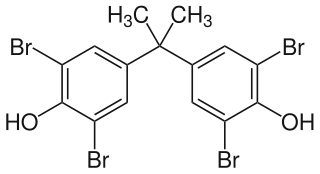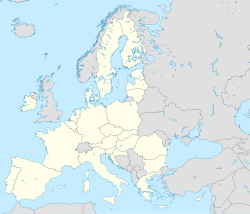A biocide is defined in the European legislation as a chemical substance or microorganism intended to destroy, deter, render harmless, or exert a controlling effect on any harmful organism. The US Environmental Protection Agency (EPA) uses a slightly different definition for biocides as "a diverse group of poisonous substances including preservatives, insecticides, disinfectants, and pesticides used for the control of organisms that are harmful to human or animal health or that cause damage to natural or manufactured products". When compared, the two definitions roughly imply the same, although the US EPA definition includes plant protection products and some veterinary medicines.

The European Centre for Disease Prevention and Control (ECDC) is an agency of the European Union (EU) whose mission is to strengthen Europe's defences against infectious diseases. It covers a wide spectrum of activities, such as: surveillance, epidemic intelligence, response, scientific advice, microbiology, preparedness, public health training, international relations, health communication, and the scientific journal Eurosurveillance. The centre was established in 2004 and is headquartered in Solna, Sweden.

Ethoxyquin (EMQ) is a quinoline-based antioxidant used as a food preservative in certain countries and originally to control scald on pears after harvest. It is used as a preservative in some pet foods to slow the development of rancidity of fats. Ethoxyquin is also used in some spices to prevent color loss due to oxidation of the natural carotenoid pigments.
A food safety agency or food administration or Food Safety Authority is a government agency responsible for ensuring the safety, quality, and proper labeling of food products within a country or region. These agencies play a crucial role in protecting public health by establishing and enforcing regulations and standards to ensure that food produced, imported, processed, distributed, and sold is safe for consumption.

SAFE FOODS is a European project established in 2004 that deals with food safety. It aims to contribute to the restoration of consumer confidence in the safety of the European food chain, to protect the consumer from foodborne illness, and to refine risk analysis practices for food safety via an interdisciplinary approach. The full title of the project is "SAFE FOODS - Promoting a new, Integrated Risk Analysis Approach for Foods". The project is funded by the European Union (EU) Directorate-General for Research via the Sixth Framework Programme, under the ‘Quality and Safety of Food’ Priority Area. SAFE FOODS is also a founding member of COMMNET, a communication managers' network of several Sixth Framework projects dealing with food quality and safety issues. More than 95 natural and social scientists are involved in the project, coming from 37 institutions in 21 countries.

Tetrabromobisphenol A (TBBPA) is a brominated flame retardant. The compound is a white solid, although commercial samples appear yellow. It is one of the most common flame retardants.
The Scientific Committee on Emerging and Newly Identified Health Risks (SCENIHR) is one of the independent scientific committees managed by the Directorate-General for Health and Consumer Protection of the European Commission, which provide scientific advice to the Commission on issues related to consumer products.
The Scientific Committee on Consumer Safety (SCCS) is one of the independent scientific committees managed by the Directorate-General for Health and Consumer Protection of the European Commission, which provide scientific advice to the commission on issues related to non-food issues. It is the successor to both the Scientific Committee on Consumer Products (SCCP) and the Scientific Committee on Cosmetic Products and Non-Food Products (SCCNFP).
The Scientific Committee on Health and Environmental Risks (SCHER) is one of the independent scientific committees managed by the Directorate-General for Health and Consumer Protection of the European Commission, which provide scientific advice to the Commission on issues related to consumer products.
The Directorate-General for Health and Food Safety, until 2014 known as the Directorate-General for Health and Consumers, is a directorate-general of the European Commission. The DG is responsible for the monitoring and implementation of European Union policies and laws on health and food safety. It is headed by European Commissioner for Health and Animal Welfare Olivér Várhelyi and Director-General Sandra Gallina.
The Scientific Committee on Food (SCF), established in 1974, was the main committee providing the European Commission with scientific advice on food safety. Its responsibilities have been transferred to the European Food Safety Authority (EFSA).
The Hungarian Food Safety Office (HFSO) operated as the Hungarian partner institution of the European Food Safety Authority (EFSA) from 2003 to 2012 in conformity with the EU requirements. One of its priority was to assess the health risks derived from food and indirectly from feed, to liaise with international and Hungarian authorities, and to communicate with the public on food safety issues. From 2012, these tasks are performed by the National Food Chain Safety Office, which was established by the integration of the Central Agricultural Office and HFSO.
Tolerable daily intake (TDI) refers to the daily amount of a chemical contaminant that has been assessed safe for human being exposure on long-term basis. TDI specifically occurs to chemicals that humans are exposed to unintentionally or as a contaminant, where acceptable daily intake refers to chemicals that are intentional added. TDI is generally written as a value of exposure per kilogram (kg) body weight. Both ADI and TDI are usually assessed based on animal experiments, and it is most often hundreds of times lower than the dose causing no observable adverse effect (NOAEL) in the most sensitive tested animal species. Because the confounding factors may vary depending on the quality of data and the type of adverse effect, TDI values are not good estimates of the harmfulness of chemicals, and must be considered administrative tools to set allowable limits for chemicals, rather than scientific measures. The threshold limit value (TLV) of a chemical substance is a level to which it is believed a worker can be exposed day after day for a working lifetime without adverse effects.
Genetic engineering in the European Union has varying degrees of regulation.

The Norwegian Scientific Committee for Food and Environment (VKM),, conducts open, independent, scientific risk assessments regarding safe food, food production and the environment upon request of the Norwegian Food Safety Authority and the Norwegian Environment Agency. VKM also carries out risk assessments on animal health, plant health, animal welfare and cosmetics for the Norwegian Food Safety Authority, and on microbiological products and alien organisms and trade in endangered species (CITES) upon request from the Norwegian Environment Agency. In addition, the Committee makes environmental risk assessments of genetically modified organisms for the Norwegian Environment Agency. The assessments are used as a basis for knowledge of the various ministries in Norway. The assessments also provide a basis for knowledge which the Norwegian Food Safety Authority uses to provide advice and determine regulations. The committee may raise matters on its own initiative. Risk assessments are made on an independent basis in accordance with internationally established methods. The scientific committee itself is to carry out risk assessments on their own initiative. The risk assessments are used by the Norwegian Food Safety Authority and the Norwegian Environment Agency when giving advice to Norwegian ministries, and when the Norwegian Food Safety Authority is developing new laws and regulations.

The Food Packaging Forum is a nonprofit foundation established in 2012 and based in Zurich, Switzerland. It is a science communication organization that provides information on chemicals in all food packaging materials and their impacts on health. In doing so, the Food Packaging Forum aims to address a wide range of stakeholders, including business decision-makers, regulators, media and communication experts, scientists, and consumers. Topics within the organization's scope of work include issues such as chemical migration, endocrine disruptors, low dose effects, and mixture toxicity. It produces educational documents about these topics in plain language.

The German Federal Institute for Risk Assessment, abbreviated BfR, is a body under public law of the German federal government with full legal capacity. The institute comes under the portfolio of the Federal Ministry of Food and Agriculture and has the task of providing scientific advice to the federal government on issues relating to food safety, product safety, chemical safety, contaminants in the food chain, animal protection and consumer health protection. Further technical supervision is performed by the Federal Ministry for the Environment, Nature Conservation, Building and Nuclear Safety and the Federal Ministry of Transport.

A pesticide, also called Plant Protection Product (PPP), which is a term used in regulatory documents, consists of several different components. The active ingredient in a pesticide is called “active substance” and these active substances either consist of chemicals or micro-organisms. The aims of these active substances are to specifically take action against organisms that are harmful to plants. In other words, active substances are the active components against pests and plant diseases.

Bisphenol A controversy centers on concerns and debates about the biomedical significance of bisphenol A (BPA), which is a precursor to polymers that are used in some consumer products, including some food containers. The concerns began with the hypothesis that BPA is an endocrine disruptor, i.e. it mimics endocrine hormones and thus has the unintended and possibly far-reaching effects on people in physical contact with the chemical.

The Artificial Intelligence Act is a European Union regulation concerning artificial intelligence (AI). It establishes a common regulatory and legal framework for AI within the European Union (EU). It came into force on 1 August 2024, with provisions that shall come into operation gradually over the following 6 to 36 months.












